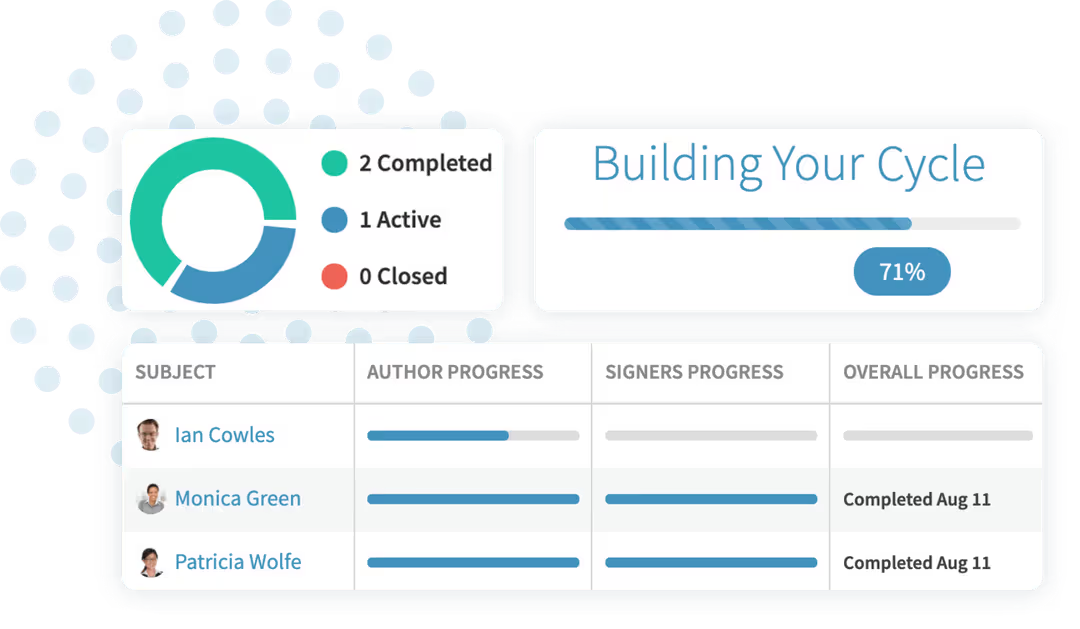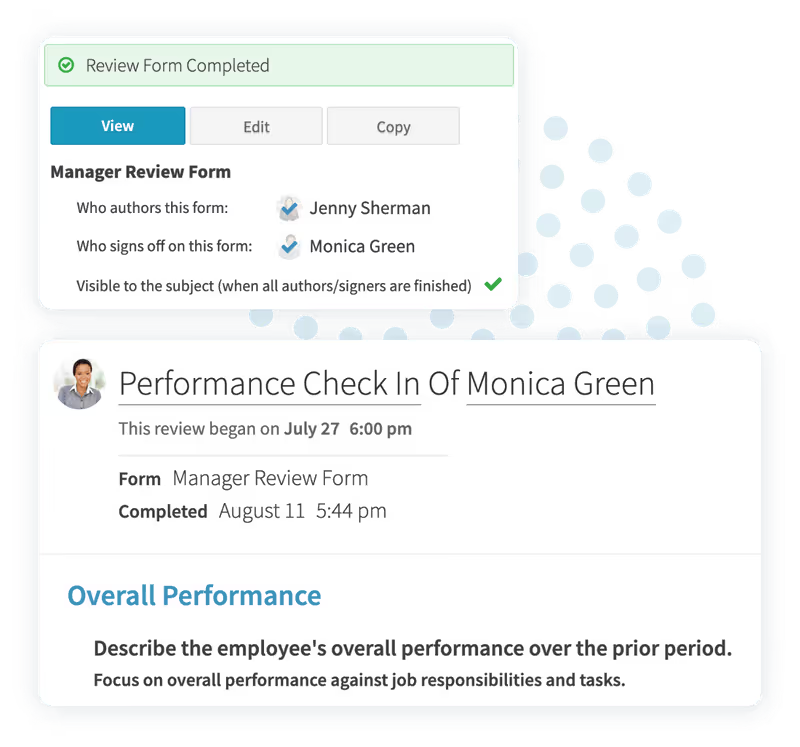Free Mid-Year Employee Performance Review Template
Here is the first rule of performance reviews: the results should never come as a surprise to your employees. Employees and managers need to have mid-year performance reviews to gauge how progress is going. One PerformYard customer explains further:
"It was really a check-in. ‘How are you?’ ‘Is there anything that I, as a manager, can do to help you?’… the check-in also serves as a way to determine if their employees are on track to meet their goals. ‘Are these goals still applicable? Do you need to make any new goals?’… ‘If someone is struggling, [the mid-year check-in] is also a really good time to talk about that." — Hailey Gruetzmacher, HR Generalist at Rockwood Capital, describing how their mid-year check-ins serve as a holistic touchpoint for employee well-being and goal progress, particularly crucial during shifts to remote work. Read the case study here.
These mid-year check-ins present a chance to reconfigure employee performance and provide solutions for areas of improvement.
Free Mid-Year Employee Performance Review Template
➔ Click here to download the PDF
The mid-year review template represents an excellent way to provide concrete feedback. Six-month reviews or semi-annual reviews give managers and direct hires a chance to examine employee performance two times during the year.
The review can help employees recalibrate performance. They ensure that targets are hit by the year-end review, which typically has the strongest impact on compensation and promotion.
The Benefits of Mid-Year Reviews
A mid-year review is an effective tool to help calibrate and focus employee performance throughout the work year. Incorporating a mid-year review into your review cycle can provide significant benefits for employee performance.

These reviews also help with review training and company strategy.
Mid-Year Reviews Calibrate Employee Performance
Imagine that you’re an employee at an organization that only gives you feedback once a year. You put your nose to the grindstone only to hear this at the end of the year:
“Hey, you haven’t been doing a satisfactory job at all!”
What!? You’d be surprised and upset. Nobody gave you any form of actionable feedback to identify your shortcomings. You were never given a chance to modify your work.
Mid-year reviews solve this problem by giving managers a feedback opportunity in the middle of the cycle. This is a chance to evaluate progress, provide feedback, and help employees modify goals. The mid-year review ensures end-of-year goals can still be achieved.
» Using UKG Performance Management? Click here to discover the better alternative.
Mid-Year Reviews Improve the Quality of Reviews
Completing reviews isn’t always intuitive. If your organization places the most weight on the end-of-year review, the mid-year review is a great way to hone a manager's review skills. The manager can learn to provide quality feedback before the end-of-year review.
Better feedback from managers will help HR and leadership make informed decisions about compensation and promotion.
Mid-Year Reviews Provide More Data
A performance management tool like PerformYard ensures each round of performance reviews provides the organization with invaluable feedback.
PerformYard helps you get a strategic view of where your organization is succeeding. It can also reveal where the organization is struggling, and where improvements can be made.
Completing two review cycles a year gives you more frequent and accurate data. This allows you to make efficient calibration decisions.
» Free OKR Template & Examples for Goals, Planning, Reporting
The Purpose of Mid-Year Reviews
It may be tempting to treat your mid-year and end-of-year review equally. This isn’t ideal. Each review should have its own purpose within the review cycle.
Most companies have a straightforward goal for their year-end review. They want to determine how well their employees performed, then tie that performance to bonuses and compensation.
Mid-year reviews work best when they are tied to employee development rather than compensation. It’s difficult to adjust salaries two times each year.
Mid-year reviews will inform the compensation decisions at the year-end review.
The mid-year review should focus on how each employee is developing:
- How well are they hitting metrics?
- Are their goals still feasible?
- Do they have the capacity to take on new projects?
Mid-year reviews should act as a developmental review. They should give employees a sense of direction without the fear of compensation being adversely affected.
How to Structure a Mid-Year Review
A mid-year review can be structured in a number of ways to best fit your organization’s needs.
A Mid-Year Review as an Informal Check-in
This is a possibility for companies that do not have the resources to devote to a lengthy review process. An informal check-in may be as simple as a scheduled meeting between a direct report and a manager.

Managers ask questions about the employee’s goals and performance. There doesn’t need to be a script or any specific evaluation.
These types of reviews can be beneficial for employees who are already tracking goal progress accurately through a performance management system. They’re good for employees who have a good sense on how they are progressing.
A Mid-Year Review as a Developmental Review Between a Manager and Employee
A more useful review structure is the developmental review. This review asks both the manager and employee to complete an evaluation on the employee’s progress over the last six months. Our free six-month review template provides a great selection of questions and metrics that you can use to design your own structure.
A more structured process provides two great benefits: documentation and data. Managers are able to document how their employees are progressing. HR can compare an employee’s self-evaluation with their manager’s evaluation. Everybody can see how well an employee is performing relative to their goals. This data can be especially useful during end-of-year reviews. It helps management see how employees performed relative to the first half of the year.
Mid-Year 360 Reviews
Many organizations are embracing 360 reviews. These are reviews that incorporate peer feedback as well as manager feedback. 360 reviews have the added benefit of seeing how an employee functions within a given team. Managers aren’t always to clearly see this dimension of an employee’s performance.
360 reviews, however, can be time consuming, as they require employees to fill out and receive several reviews. This results in a longer review cycle, which can be complicated if done multiple times a year.

Some organizations have adopted different review structures for different times of the year. For example, the mid-year review may be kept between the employee and the manager, but the end-of-year review may be a robust 360 review process. It all depends upon your organization, your resources, and the time you have available.
Example Mid-Year Performance Review Phrases
Positive Feedback Examples
- Your ability to meet and exceed set targets has been impressive. Your dedication to achieving these goals demonstrates a strong commitment to our team's success.
- Your creative approach to problem-solving has greatly contributed to our team's innovation. Your ideas have been both refreshing and impactful.
- So far this year you have developed exceptional skills in managing time and prioritizing tasks. This has not only increased your productivity but also set a great example for the team.
- Your willingness to collaborate and seek feedback has enhanced the quality of your work and fostered a positive environment in our team.
- Your consistent reliability in completing assignments and your attention to detail have been key factors in our project's success so far this year.
Critical Feedback Examples
- While your performance has been good, there is room for improvement in meeting project deadlines. Let's explore strategies to enhance your time management skills.
- I've observed some challenges in your interactions with team members. Focusing on effective communication and teamwork should improve your cohesion with your team members.
- So far this year, there seems to be a discrepancy between your potential and your current output. Let's identify any obstacles you're facing and work on ways to optimize your performance.
- I encourage you to take more initiative in proposing new ideas and solutions. Your input is valuable, and increased engagement can lead to more innovative outcomes.
- Attention to detail in your work has occasionally been lacking. Ensuring accuracy is crucial, so let's look at ways to improve in this area for the upcoming projects for the rest of the year.
How PerformYard Can Improve Your Mid-Year Reviews
PerformYard streamlines the review process. The centralized, single sign-on platform works for for all employees. Every member of your workforce can complete their reviews without paper forms or emails.
PerformYard allows HR to craft unique mid-year performance review templates. HR can also kick-off review schedules through scheduled emails and automatically send reminder emails to employees. PerformYard takes care of tracking down the stragglers who are late turning in their reviews.
According to PerformYard's State of Performance Management Report, companies using performance management software for four years complete goals at a 60% higher rate than they did in their first year. This dramatic improvement highlights that effective performance management is a learned organizational capability. Mid-year reviews play a crucial role in this process by allowing for timely adjustments to goals and ongoing feedback, ensuring employees remain on track and fostering continuous development. This contributes significantly to the long-term success of performance management initiatives and improved goal achievement.
Ready to learn more about how PerformYard can streamline your mid-year review process? Request a demo and see why PerformYard is the #1 rated performance management solution.
Frequently Asked Questions
How do you write a mid-year performance review?
The best way to write a mid-year performance review is to focus on employee development. Ask pointed questions about employees meeting their goals. Seek examples of employees’ work succeeding or embodying the values of your organization.
How do I prepare for a 6-month performance review?
Employees should examine progress relative to goals and organizational values. Try to discover where you are succeeding and where you are struggling. Bring these successes and challenges to your manager’s attention.
Where can I get a mid-year review template?
You can download our free mid-year review template here.
Should mid-year performance reviews be tied to compensation?
Mid-year reviews work best when tied to employee development. These reviews shouldn’t play a role in employee compensation. End-of-year reviews are the best time to examine compensation.
Is a mid-year performance review the same as a year-end performance review?
While they can be designed similarly, it is beneficial to have separate goals for each review. Mid-year reviews are best seen as employee progress reports. They’re meant to help employees recalibrate their efforts to meet year-end targets.



.jpg)

